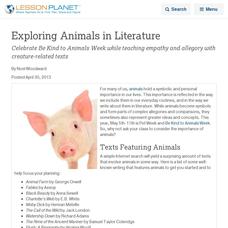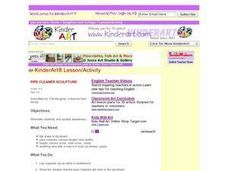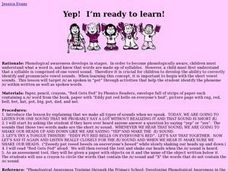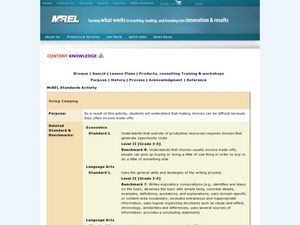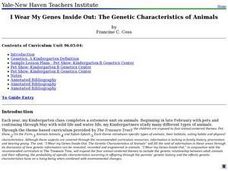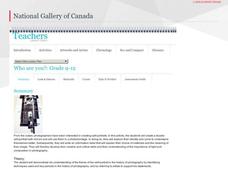Curated OER
Differences Between Fiction And Non-Fiction in the Library
Students examine the differences between fiction and non-fiction books in the library by discussing kangaroos. They distinguish between facts about kangaroos, and using their imaginations and imagining what they would do with pet kangaroos.
Curated OER
Ani-mania
Students view and discuss Robert Harris' farm landscapes and create their own mural out of wood. In groups, they discuss various issues affecting pets throughout the world and create a way to protest or celebrate the issue. They try to...
Curated OER
E-E-E-E-Extra E-E-E-E-Effort
Young scholars listen to a tongue twister emphasizing the short e sound. They practice writing the letter e and attaching different words with that sound to it. They listen to a book about a dog that enhances the letter e. They write...
Curated OER
Scary A-a-a-a!
Students study the letter a in order to recognize it, say its /a/ sound, and write it. They pretend to be scared and say, "Aaaa" before reciting a tongue twister. Next, they practice writing the letter and listen to a read aloud of "A...
Michigan State University
Friend or Foe?
What one person thinks is a pest may not be a pest to someone else. Here, scholars examine the characteristics of living things and pests through grand conversation and a variety of activities. Class members play a game of pest or not a...
Curated OER
Animal Homes
Students explore how an animal's relationship to its habitat affect the animal's survival. They discuss animal habitats and the animal's relationship to that habitat through the food chain, life cycle, community, and balance of nature....
Curated OER
Exploring Animals in Literature
Celebrate Be Kind to Animals Week while teaching empathy and allegory with creature-related texts
Bulgarian Creative Writing Competition
Creative Writing Prompts For Every Season and Month
Winter, spring, summer, and fall! Every season is covered in a 14-page list of writing prompts. Included are story starters, reflection questions, poetry topics, and more.
Cornell Lab of Ornithology
Investigating Evidence
Explore the scientific process through nature. Scholars become scientists as they develop a question, design an experiment, collect data, and analyze their results. A two-week lesson guides your classes through the process and provides...
Curated OER
Books for Teaching "All About Me!"
Students learn about experiences and feelings through books. In this instructional activity, students read a variety of books to aid in their understanding of life. Through a listing and brief synopsis of twelve books, students explore...
Curated OER
Introduce Vocabulary: Franklin's New Friend (Bourgeois)
Franklin the turtle makes a new friend as youngsters learn vocabulary in context using Paulette Bourgeois' story (tip: this strategy can be applied to any book). Brief kids on the new words so they can raise their hands when they...
WITS Program
Whoever You Are
Deep down, everyone is the same. Discuss the similarities and differences between people across cultures with a series of reading activities based on the beautiful story and illustrations in Whoever You Are by Mem Fox.
Curated OER
Pipe Cleaner Sculpture
Learners of any age can make the most out of their pipe cleaners. This art project idea is very simple and yet, it could result in some amazing works of art. They use pipe cleaners, flat styrofoam, straws, pasta, and beads to create...
Curated OER
Yep, I'm Ready to Learn!
Tongue twisters give young learners an easy phrase to refer back to when learning letter sounds. Use the phrase "Eddy put red bells on everyone's bed" to identify the /e/ sound. Then read Red Gets Fed aloud, having learners nod...
Curated OER
Time to Rhyme
Learners sing along to a hello song. They develop skills of phonemic awareness, literacy and social awareness. They think of words that rhyme with their names to add to the song.
Curated OER
Washing Hands
Students formulate questions about a germ book before it is read to them. In this washing hands lesson plan, the teacher gets glitter on each students hands that represents germs. Before the teacher reads a book about germs the students...
Curated OER
Read Aloud Lesson Plan: Water for One, Water for Everyone
Students listen to a read aloud about African animals as they access a watering hole. They discuss the characteristics of Africa such as the temperature, it distance from the students, and lifestyle of the animals. They talk about how...
Curated OER
"Going Camping"
Students review the difference between "wants" and "needs." Students apply acquired knowledge by preparing for a pretend camping trip. Students plan out their trip together and then revise their list twice.
Curated OER
An Introduction to 'Opae 'ula
Students examine the 'opae 'ula. In this science lesson, students observe a live specimen and identify the major body parts. Students construct habitat jars and observe the 'opae 'ula behaviors.
Curated OER
Respecting Differences
Students move around the room to express opinions on specific questions. For this opinions lesson, students explore their feelings about the opinions they express.
Curated OER
A? Speak up, I can't hear you!
Pupils become phonemically aware of various sounds that make up written words. This lesson focuses on the vowel correspondence a_e=/A/. They decode the long a mouth moves in words as well as practice spelling the words themselves.
Curated OER
I Wear My Genes Inside Out: The Genetic Characteristics of Animals
Pupils create mixed breed dogs using paper illustrations of various breeds. They label dogs created by students using the Genetics Center and discuss the aspects of genetics that affect the outcome of the various projects.
Curated OER
The Scary, Creaky Door
Young scholars recognize the short vowel e in written and spoken language. Through listening and matching activities, they discriminate the vowel sound /e/ from other phonemes. Students identify the phoneme and letter in pictures using a...
Curated OER
Who Are You?
Students complete self projects such as a collage, an acrostic poem, a mural, and more, to show their similarities and differences. In this similarities and differences lesson plan, students can do these projects individually or in groups.






